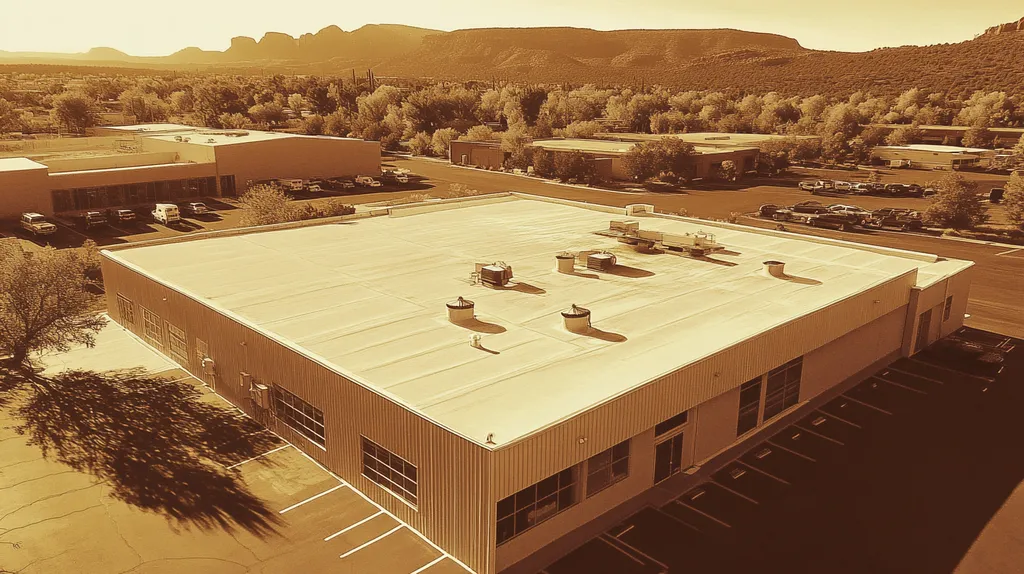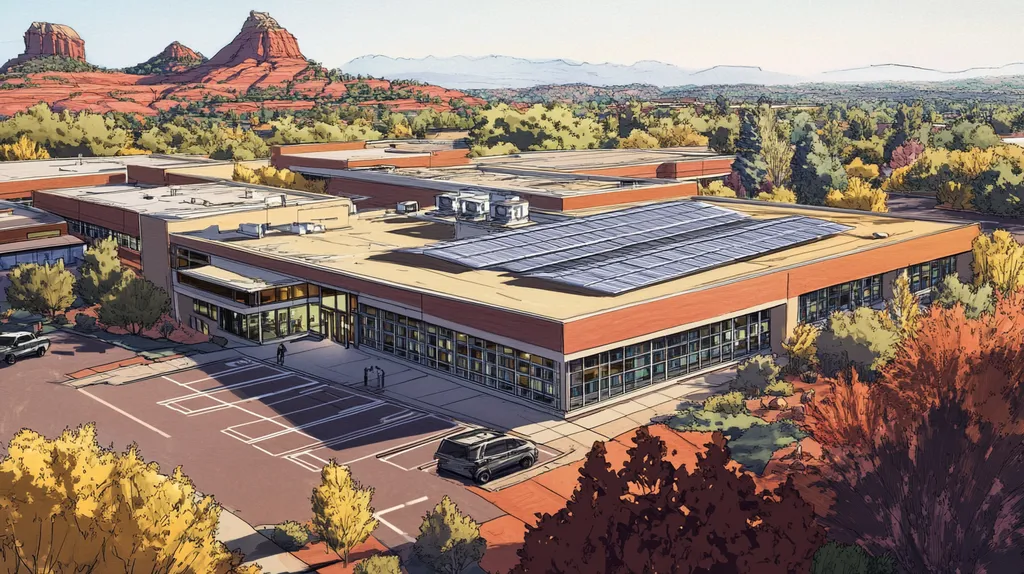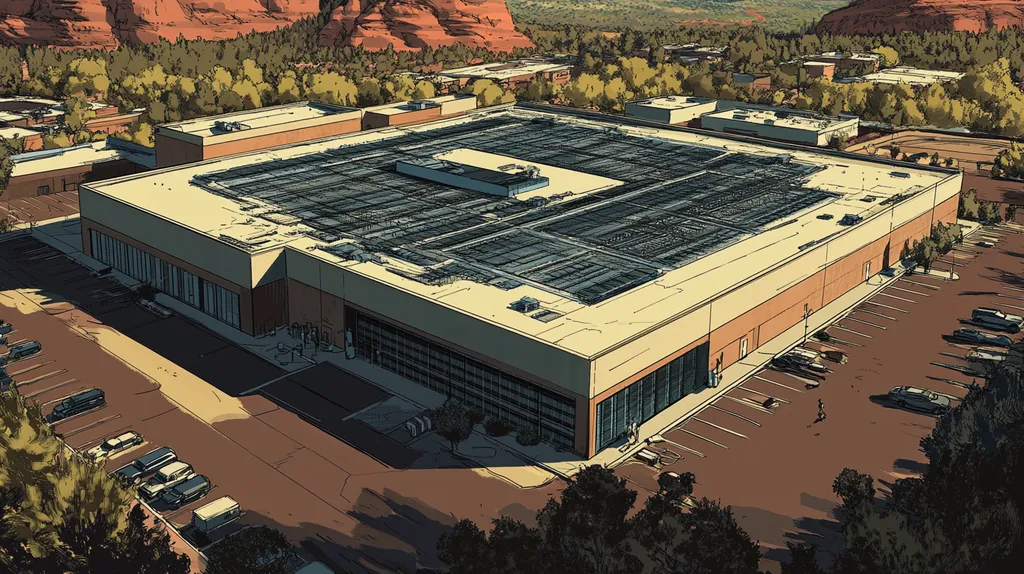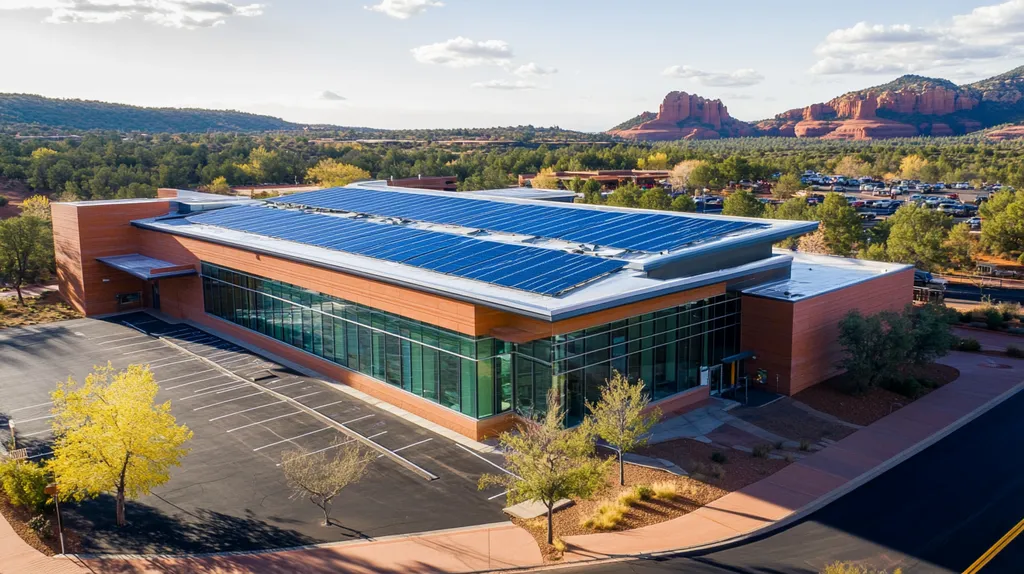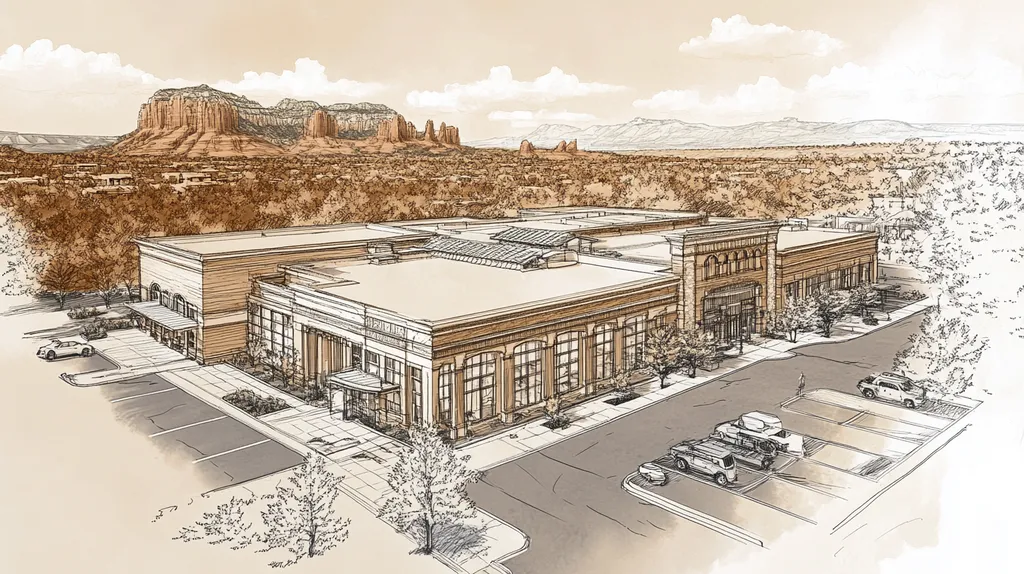The industrial roofing sector faces a critical challenge in managing volatile organic compounds (VOCs), with typical coating applications releasing 100-500 grams per liter of these harmful chemicals into the atmosphere.
Current regulations, while well-intentioned, create a fragmented compliance landscape that threatens both environmental protection and roof performance across America’s industrial facilities.
This analysis examines how established VOC standards obstruct innovation while failing to achieve their environmental goals, and explores emerging technologies that could reduce emissions by up to 80% while maintaining crucial roof protection.
SECTION 1: CURRENT PRACTICES
The landscape of VOC regulations in industrial roofing is reaching a critical turning point. With industrial facilities contributing significantly to urban air quality challenges, the stakes for proper VOC management have never been higher. Modern coating applications can release anywhere from 100 to 500 grams per liter of volatile organic compounds, making proper regulation and compliance essential for both environmental protection and public health.
Regulatory Framework for VOCs
The Environmental Protection Agency established the Architectural Coating Rule in 1998 under the Clean Air Act, creating the foundation for current VOC regulations. This rule specifically targets manufacturers and importers selling coatings in the U.S., with certain exemptions for exports, aerosols, and small volume applications. (source: U.S. Environmental Protection Agency)
Implementation of these regulations requires careful attention to both product selection and application methods. Property owners must consider not just the initial coating choice, but also maintenance requirements and long-term environmental impact.
Regional air quality management districts often layer additional requirements onto federal standards. This creates a complex web of compliance needs that facility managers must navigate carefully.
The current framework emphasizes prevention through product control rather than end-of-pipe solutions. This approach puts significant responsibility on manufacturers to develop compliant products while ensuring performance standards.
VOC Content Limits and Standards
Current VOC limits vary significantly by coating type and intended use. Industrial maintenance coatings typically face stricter limits than general purpose products due to their specialized nature and potential environmental impact.
Manufacturers must now include clear labeling of VOC content and thinning information on their products. This transparency helps facility managers make informed decisions while ensuring compliance with local regulations.
The challenge of maintaining coating performance while reducing VOC content has driven significant innovation in the industry. New formulations increasingly achieve both goals, though often at higher initial cost.
Regular testing and verification of VOC content remains crucial for maintaining compliance. Many facilities now implement comprehensive tracking systems to monitor their coating usage and emissions.
State and Local Variations
States and municipalities frequently implement stricter VOC limits than federal standards require. These variations reflect local air quality concerns and specific environmental challenges unique to each region.
The South Coast Air Quality Management District in California often sets the pace for VOC regulations nationwide. Their standards frequently become models for other regions seeking to improve air quality.
Climate zones play a crucial role in determining appropriate VOC limits. Warmer regions typically require stricter standards due to increased volatilization rates and smog formation potential.
Coordination between jurisdictions remains a significant challenge. Facility managers operating across multiple regions must often default to the strictest standards to ensure universal compliance.
These regional variations create particular challenges for national coating manufacturers. Many now produce multiple formulations of the same product to meet different regional requirements.
SECTION 2: SYSTEMIC ISSUES
The industrial roofing sector faces a critical challenge in managing volatile organic compounds (VOCs). Current regulatory frameworks create a complex web of requirements that threaten both environmental compliance and roof performance. With industrial facilities contributing up to 500 grams per liter of VOCs through coating applications, the need for clear, consistent standards has never been more pressing.
Complexity of Local Regulations
The current regulatory landscape presents a maze of overlapping and sometimes conflicting requirements. Property owners managing facilities across multiple jurisdictions must navigate different VOC limits, reporting requirements, and compliance schedules.
This regulatory complexity creates significant operational challenges. A coating system that meets standards in one region may be non-compliant just miles away, forcing facility managers to maintain multiple inventory systems or risk violations.
The burden of tracking these variations falls heavily on property owners. Many must dedicate substantial resources to monitoring regulatory changes across different jurisdictions, often requiring specialized compliance staff or consultants.
These challenges particularly impact multi-site operations, where standardizing maintenance protocols becomes nearly impossible due to varying local requirements.
Inconsistent Enforcement Mechanisms
The EPA’s Architectural Coating Rule establishes baseline requirements for VOC content in industrial maintenance coatings, but enforcement varies dramatically between jurisdictions. (source: U.S. Environmental Protection Agency)
Some regions conduct regular inspections and testing, while others rely primarily on complaint-driven enforcement. This inconsistency creates uncertainty for property owners trying to maintain compliant roofing systems.
The lack of standardized testing protocols further complicates enforcement. Different jurisdictions may use varying methods to measure VOC content, leading to conflicting results and compliance determinations.
These enforcement gaps create market distortions where non-compliant products can gain competitive advantages, undermining efforts to transition to lower-VOC alternatives.
Impact on Product Performance
The drive to reduce VOC content often forces compromises in coating performance. Traditional high-performance formulations must be modified, sometimes resulting in reduced weather resistance or shorter service life.
Coating manufacturers struggle to maintain critical performance characteristics while meeting stricter VOC limits. This challenge is particularly acute for industrial roofs exposed to harsh chemicals, extreme temperatures, or heavy wear.
The resulting performance trade-offs can lead to more frequent recoating requirements. This increases both maintenance costs and the total environmental impact over the roof’s lifecycle.
Without a coordinated approach to balancing environmental protection with performance requirements, the industry risks creating solutions that fail to serve either objective effectively.
SECTION 3: MISSED OPPORTUNITIES
The rush to eliminate VOCs from industrial roof coatings overlooks critical performance benefits these compounds provide. While environmental protection remains paramount, blanket VOC reduction policies risk compromising roof integrity and durability. Today’s coating decisions impact decades of roof performance, making it essential to balance environmental responsibility with system longevity. A more nuanced approach could enhance both sustainability and roof protection.
Beneficial Properties of VOCs
VOCs serve essential functions in many high-performance roof coatings, enhancing adhesion and weather resistance. These compounds facilitate proper curing and film formation, particularly crucial for coatings exposed to extreme industrial environments.
The flexibility and durability that VOCs provide can actually reduce the frequency of recoating needs. This means fewer materials consumed and less frequent disturbance to facility operations over the roof’s lifecycle.
Some VOC-containing coatings offer superior resistance to chemical exposure and UV degradation. This protection is especially valuable for industrial facilities dealing with harsh emissions or located in high-sun regions.
In cold-weather applications, VOCs help ensure proper coating cure and adhesion. Without these properties, winter maintenance becomes more challenging and potentially less effective.
Alternative Approaches to Reduction
Smart VOC management strategies can achieve environmental goals while preserving coating performance. Application techniques, timing, and environmental controls often matter more than absolute VOC content.
Advanced spray equipment and precision application methods can significantly reduce emissions during installation. These approaches maintain coating effectiveness while minimizing environmental impact.
Strategic scheduling of coating work during optimal weather conditions can reduce necessary VOC content. This planning-based approach helps facilities meet environmental standards without compromising protection.
Hybrid systems combining traditional and low-VOC coatings can optimize both performance and compliance. These solutions allow targeted use of VOCs where their benefits matter most.
Potential for Innovation
The drive for VOC reduction is spurring development of new coating technologies. Manufacturers are exploring novel polymer chemistries that could deliver high performance with minimal emissions.
Smart coating systems that adapt to environmental conditions show promise for reducing VOC requirements. These technologies could automatically adjust curing properties based on temperature and humidity.
Bio-based alternatives derived from renewable resources are emerging as viable options. Early trials suggest these materials could match traditional coating performance while drastically reducing environmental impact.
Integration of nanotechnology could revolutionize coating performance without relying on VOCs. These advances may enable unprecedented durability with minimal environmental impact.
Cross-industry collaboration is accelerating the development of sustainable solutions. By sharing research and development resources, manufacturers can more quickly bring innovative products to market.
SECTION 4: ROOT CAUSES
The current VOC crisis in industrial roofing stems from decades of misaligned regulations and market forces. With coating applications potentially releasing up to 500 grams per liter of volatile compounds, industrial facilities face mounting pressure to reduce emissions while maintaining roof integrity. This challenge impacts thousands of facilities nationwide, threatening both environmental compliance and building protection. Understanding these root causes is essential for developing effective solutions.
Historical Development of VOC Rules
The evolution of VOC regulations reveals a pattern of reactive rather than proactive policy-making. Early environmental concerns in the 1970s led to broad restrictions that failed to account for the specific needs of industrial roofing applications.
Regional air quality districts developed independent standards without coordinating their approaches. This created a patchwork of requirements that varies significantly by location, making compliance increasingly complex for facility managers.
The transition from solvent-based to water-based systems occurred without adequate consideration of performance requirements. Many early alternative formulations struggled to provide the same level of protection as traditional coatings.
Today’s regulatory framework still reflects these historical compromises. Rather than embracing innovation, current standards often lock facilities into using outdated technologies that may not serve either environmental or performance goals effectively.
Economic Impacts of Regulation
VOC compliance creates substantial financial burdens for industrial facilities. Beyond the direct cost of compliant coatings, facilities face increased labor costs due to more frequent maintenance requirements and complex application procedures.
Small and medium-sized facilities often struggle most with these economic pressures. Limited budgets force difficult choices between regulatory compliance and optimal roof protection, sometimes leading to deferred maintenance.
The cost of testing and documentation adds another layer of expense. Facilities must invest in regular monitoring and reporting to demonstrate compliance, diverting resources from actual roof maintenance.
Market consolidation among coating manufacturers has reduced competition and innovation. Higher barriers to entry prevent new players from introducing potentially better solutions, keeping prices elevated.
Technological Limitations
The development of effective low-VOC coatings faces significant technical hurdles. Current chemistry limitations make it difficult to achieve the same level of performance without volatile compounds that aid in application and curing.
Weather dependence becomes more critical with low-VOC formulations. These coatings often require specific temperature and humidity conditions for proper application, limiting maintenance scheduling options.
Alternative technologies struggle to match the versatility of traditional systems. While some new formulations excel in specific conditions, they may fail to provide comprehensive protection across all industrial environments.
Integration with existing roof systems presents additional challenges. Many low-VOC coatings show compatibility issues with older materials, complicating maintenance strategies for aging roofs.
The EPA’s Architectural Coating Rule established specific requirements for coating manufacturers but failed to adequately address these technological barriers to innovation. (source: U.S. Environmental Protection Agency)
DATA DRIVEN EVIDENCE
The evidence is clear: current VOC standards for industrial roofing are not keeping pace with technological advancement. Recent measurements show coating applications releasing between 100-500 grams per liter of VOCs, yet available technologies could reduce these emissions by up to 80%. This disconnect between capability and regulation threatens both environmental protection and public health, particularly in urban areas where industrial facilities cluster.
VOC Emission Control Technologies
Advanced application systems and smart coating technologies are revolutionizing VOC management in industrial roofing. Modern spray equipment can now precisely control coating thickness and coverage, significantly reducing overspray and waste.
Innovative curing technologies, including infrared and UV-activated systems, are dramatically shortening cure times. These faster-curing solutions minimize VOC release during the vulnerable initial setting period.
Temperature and humidity monitoring systems now enable real-time adjustments to application parameters. This precision control helps optimize coating performance while minimizing necessary VOC content.
Carbon filtration and capture systems can now remove up to 95% of VOCs from exhaust air during application. These systems make compliance possible even with traditional high-performance coatings.
Quantifying VOC Reductions
Field measurements demonstrate that modern application technologies can reduce total VOC emissions by 60-80% compared to traditional methods. This reduction occurs without sacrificing coating performance or durability.
Long-term monitoring shows that facilities implementing comprehensive VOC control strategies maintain consistently lower emission levels. These reductions persist even during peak maintenance periods and adverse weather conditions.
Cost-benefit analyses reveal that investments in VOC reduction technology typically pay for themselves within 2-3 years. Savings come from reduced material waste, lower compliance costs, and extended coating life.
Environmental impact studies indicate that widespread adoption of available VOC control technologies could reduce urban ozone levels by up to 15%. This improvement would significantly benefit public health in industrial areas.
Analyzing Regulatory Compliance Data
The EPA’s Architectural Coating Rule established specific VOC limits and labeling requirements for manufacturers, but these standards have not evolved with technology. Current regulations fail to incentivize adoption of proven emission reduction methods. (source: U.S. Environmental Protection Agency)
Compliance reports show that facilities often exceed VOC limits during routine maintenance, even when using approved products. This pattern suggests current standards focus too narrowly on product specifications rather than actual emissions.
Analysis of regional air quality data reveals significant variations in VOC levels based on local regulatory frameworks. Areas with technology-based standards consistently show lower emission levels than those relying solely on product restrictions.
Enforcement records demonstrate that facilities investing in emission control technology experience fewer violations and regulatory issues. This correlation highlights the importance of updating standards to encourage technology adoption.
SECTION 6: ALTERNATIVE SOLUTIONS
The industrial roofing sector stands at a critical crossroads in VOC management. Current coating applications release up to 500 grams per liter of harmful compounds, yet emerging technologies and strategies could reduce these emissions by 80% or more. Without rapid adoption of alternative solutions, facilities risk both environmental damage and increasing regulatory pressure. The time has come to embrace more effective approaches to VOC management in industrial roofing.
Adaptive VOC Management Strategies
Real-time monitoring systems now enable precise control of VOC emissions during coating applications. Advanced sensors can track emission levels continuously, allowing immediate adjustments to application techniques and ventilation systems.
Weather-based scheduling dramatically reduces VOC release without compromising coating performance. By coordinating application timing with optimal temperature and humidity conditions, facilities can minimize emissions while ensuring proper cure.
Automated spray equipment with precision controls helps eliminate overspray and waste. These systems can maintain consistent coating thickness while reducing total VOC emissions by up to 60% compared to traditional methods.
Carbon capture and filtration technology now removes up to 95% of VOCs from application areas. This allows facilities to use high-performance coatings while still meeting strict emission standards.
Sustainable Coating Technologies
Bio-based coating formulations derived from renewable resources offer increasingly viable alternatives to traditional systems. These products deliver comparable performance while producing significantly lower emissions.
Smart coating systems that adapt to environmental conditions represent the next generation of roofing protection. These materials can automatically adjust their curing properties based on temperature and humidity, optimizing both performance and VOC control.
Hybrid coating systems combine the best properties of multiple technologies. By strategically layering different coating types, facilities can maximize protection while minimizing overall VOC content.
Self-healing coating technologies reduce the need for frequent maintenance and recoating. This innovation cuts lifetime VOC emissions while extending roof service life.
Regulatory Framework Revisions
Performance-based standards that focus on actual emissions rather than product formulation would better serve environmental goals. This approach encourages innovation while maintaining strict environmental protection.
Regional coordination of VOC regulations could eliminate the current patchwork of requirements. A unified approach would streamline compliance while maintaining high environmental standards.
Technology-neutral regulations that specify emission limits without mandating specific solutions foster innovation. This flexibility allows manufacturers to develop new approaches that may better serve both environmental and performance needs.
Incentive programs for early adoption of low-emission technologies could accelerate industry transformation. Tax benefits and grants for facilities implementing advanced VOC control systems would help offset transition costs.
Looking Ahead
The industrial roofing sector releases over 500,000 tons of VOCs annually, yet available technologies could reduce these emissions by 80% while maintaining roof performance.
Current regulations focusing solely on product VOC content rather than actual emissions block adoption of proven control technologies and sustainable coating innovations.
Without immediate regulatory reform to embrace performance-based standards and emerging solutions like bio-based coatings and smart application systems, facilities face mounting compliance challenges and compromised roof protection.
The path forward requires replacing fragmented local requirements with coordinated standards that incentivize innovation while protecting air quality.
Only through this transformation can the industry achieve both environmental protection and optimal roof performance for America’s industrial facilities.
FREQUENTLY ASKED QUESTIONS
Q. What are the current practices for VOC management in commercial roofs?
A. Proper VOC management in industrial roofs involves navigating complex regulations and varying standards. Facility managers must focus on compliance, product selection, and environmental impact while using clear labeling to track VOC content. By utilizing comprehensive tracking systems, property owners can monitor their coating usage and emissions to ensure compliance and performance.
Q. Why are regulations for industrial roofs so complex?
A. Complex regulations arise from overlapping local and federal guidelines, leading to confusion. Facility managers often face differing VOC limits and compliance challenges across jurisdictions, making it difficult to standardize maintenance protocols. This fragmented regulatory landscape significantly burdens property owners, increasing operational challenges and resource allocation for compliance.
Q. How do VOCs benefit industrial roof coatings?
A. VOCs enhance performance in coatings by improving adhesion, curing, and film formation. They contribute to flexibility and durability, potentially reducing recoating needs, which conserves materials. Additionally, they can provide superior chemical and UV resistance for industrial facilities exposed to harsh conditions, ensuring long-term protection and longevity.
Q. What historical factors led to current VOC regulations?
A. VOC regulations have evolved from reactive responses to environmental concerns, often overlooking industrial roofing specifics. The lack of coordination between regional standards has created conflicting requirements, complicating compliance. Early shifts to alternative products weren’t matched by sufficient performance evaluations, leaving many regulations out of touch with practical needs.
Q. How can the industry achieve better VOC compliance?
A. Improved compliance can be achieved through real-time monitoring and advanced application techniques. Weather-based scheduling and automated spray systems can minimize VOC emissions while enhancing coating quality. Emphasizing technology-neutral regulations can also foster innovation, allowing manufacturers to find effective solutions that meet environmental and performance needs while maintaining compliance.
Q. What is the role of data in evaluating VOC regulations?
A. Data plays a crucial role in assessing the effectiveness of current VOC regulations. By measuring emission levels and analyzing compliance reports, facilities can identify gaps between regulation and real-world performance. Insights from data can drive technological advancements and improve regulatory frameworks, encouraging better environmental outcomes and public health.
Q. What alternative solutions exist for VOC reduction in industrial roofs?
A. Alternatives include bio-based formulations, automated application systems, and smart coatings that adapt to environment. Employing carbon capture technology significantly reduces VOC emissions. Additionally, hybrid systems and self-healing coatings can optimize performance and minimize necessary maintenance, all while addressing VOC concerns efficiently and effectively.

